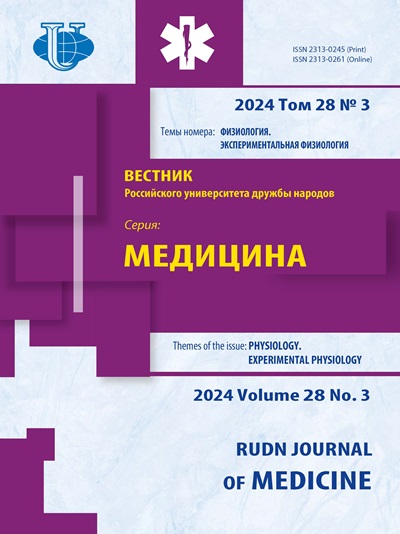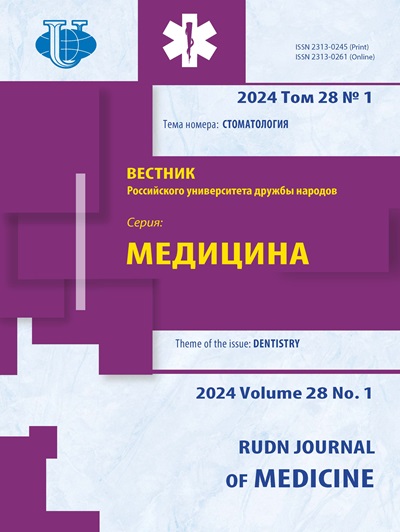An integrated approach to the diagnosis, treatment and prevention of caries in early and preschool age children
- Authors: Simonenko D.A.1, Zhurbenko V.A.1, Karlash A.E.1
-
Affiliations:
- Kursk state medical university
- Issue: Vol 28, No 1 (2024): DENTISTRY
- Pages: 23-34
- Section: Stomatology
- URL: https://journals.rudn.ru/medicine/article/view/38294
- DOI: https://doi.org/10.22363/2313-0245-2024-28-1-23-34
- EDN: https://elibrary.ru/UIZFLI
Cite item
Full Text
Abstract
Relevance. Dental caries, according to World Health Organization, is one of the most common diseases in children throughout the world. In the absence of timely diagnosis and treatment, the carious process can affect not only the efficiency of chewing function, but also speech, smile and, as a consequence, psychosocial adaptation, as well as the quality of life of the child and family. Despite the fact that the etiological factors have been well known for many years, reducing the number of teeth affected by caries in children still remains an urgent task. This article is a review of information sources about the prevalence, etiology and integrated approach to the diagnosis, treatment and prevention of dental caries in children. The authors analyzed scientific data in the search engines PubMed, Google Scholar and eLibrary. Conclusion . Based on the literature review, a number of modern trends were identified that define a series of key hypotheses that summarize the accumulated material and confirm the prospects and relevance of the problem. The goal is to help clinicians recognize common patterns of caries in children and make appropriate decisions regarding the diagnosis, treatment and prevention of carious lesions, taking into account available methods, materials, knowledge, age and patient history. It is also important to create a comfortable and safe environment during the appointment, as unfamiliarity with a new physical interaction can provoke anxiety as a standard response to uncertainty, which often results in childhood dental phobia, contributing to behavioral resistance to return visits. In general, based on the analysis, we can conclude that the use of an integrated approach to diagnosis and treatment has great potential for achieving better results in working with dental patients of early and preschool age, the development and improvement of which should remain a priority to ensure more complete and effective treatment of children and maintaining their health in the long term.
About the authors
Daniil A. Simonenko
Kursk state medical university
Author for correspondence.
Email: vip.simonenko02@bk.ru
ORCID iD: 0009-0005-8848-1682
Kursk, Russian Federation
Veronika A. Zhurbenko
Kursk state medical university
Email: vip.simonenko02@bk.ru
ORCID iD: 0000-0002-2457-7627
Kursk, Russian Federation
Anastasiya E. Karlash
Kursk state medical university
Email: vip.simonenko02@bk.ru
ORCID iD: 0000-0002-8998-9681
Kursk, Russian Federation
References
- Maslak EE, Rodionova AS, Yanovskaya ML, Stavskaya SV. Modern concepts of primary teeth caries treatment in young children. Clinical dentistry. 2015;75(3):8–12. (In Russian).
- Folayan M, Olatubosun S. Early Childhood Caries — A diagnostic enigma. Eur J Paediatr Dent. 2018;19(2):88. doi: 10.23804/ejpd.2018.19.02.00
- Zhurbenko EE, Karlash AS. Study of the prevalence and intensity of dental caries among preschool children. Regional’nyi vestnik. 2020;44(5):17–19. (In Russian).
- Drury TF, Horowitz AM, Ismail AI, Maertens MP, Rozier RG, Selwitz RH. Diagnosing and reporting early childhood caries for research purposes: A report of a workshop sponsored by the National Institute of Dental and Craniofacial Research, the Health Resources and Services Administration, and the Health Care Financing Administration. Journal of Public Health Dentistry. 1999;59(3):192–7. doi: 10.1111/j.1752‑7325.1999.tb03268.x
- American Academy of Pediatric Dentistry Council on Clinical Affairs. Policy on Early Childhood Caries (ECC): Classifications, Consequences, and Preventive Strategies. Pediatr Dent. 2018;40(6):60–62.
- Alazmah A. Early childhood caries: A Review. The Journal of Contemporary Dental Practice. 2017;18(8):732–737. doi: 10.5005/jp‑journals‑10024‑2116
- Keels MA. Personalized dental caries management in children. Dental Clinics of North America. 2019;63(4):621–9. doi: 10.1016/j.cden.2019.06.002
- Glinkin VV, Klemin VA, Glinkina VV. Modern view on the theory of caries development. In: Gulyaev GY, editors. Innovation processes in science, economy and education: theory, methodology, practice. Penza: Science and Enlightenment; 2017. p. 191–201. (In Russian).
- Starovoytova EL, Antonova AA, Strelnikova NV. Literature review: dental caries in young children as a socially significant public health problem. Dal’nevostochnyi meditsinskii zhurnal. 2018;3:106–111. (In Russian).
- Vecherkina ZHV, Smolina AA, Popova TA, Kubyshkina KP, Oleinik OI. Etiological aspects of dental caries and its prevention. System analysis and management in biomedical systems. 2020;19(2):79–86. doi: 10.36622/vstu.2020.19.2.012 (In Russian).
- Zaitsev AV, Boychenko ON, Nikolyshyn AK. Status of Methodology in Cariesology and Opportunities for its Improvement. Vestnik problem biologii i meditsiny. 2015;2(2):96–101 (In Russian).
- Baroeva AR, Mamieva SC. Features of pathogenesis and prevention of early child caries. Modern Issues of Biomedicine. 2022;6(1). doi: 10.51871/2588‑0500_2022_06_01_1 (In Russian).
- Shakovets NV, Antonenko AN. Epidemiology, etiology, risk assessment, prevention, education and management of early childhood caries. Sovremennaya stomatologiya. 2019;76(3):14–19. (In Russ).
- Leontyev VK. On Etiology of Dental Caries. The Dental Institute. 2019;82(1):34–35. (In Russian).
- Ivanova GG, Zhorova TN. Study of the statistical average electrical conductivity of hard dental tissues from the moment of their eruption in dynamics in order to diagnose pathological processes of teeth with unfi nished mineralization of enamel. The Dental Institute. 2020;88(3):87–90. (In Russian).
- Jargin SV. Minimally invasive dentistry — theory and perspective. Sovremennaya stomatologiya. 2023; 90(1):2–6. doi: 10.24108/preprints‑3112664 (In Russian).
- Dikmen B. ICDAS II criteria (international caries detection and assessment system). Journal of Istanbul University Faculty of Dentistry. 2015;49(3):63. doi: 10.17096/jiufd.38691
- Krämer N, Koch JH, Emami-Namini A, Frankenberger R. Prävention, Diagnostik und Therapie der Fissurenkaries bei Bleibenden Zähnen. Oralprophylaxe & Kinderzahnheilkunde. 2014;36(3):97–106. doi: 10.3238/opkzh.2014.0097‑0106
- Shakavets NV, Naumovich DN, Cherniauskaya ND. Modern methods of occlusal caries diagnosis in children. Dentistry Aesthetics Innovations. 2022;(4):357–366. doi: 10.34883/pi.2022.6.4.002 (In Russian).
- Chibisova MA, Batukov NM. Methods of x-ray examination and modern radiation diagnostics used in dentistry. The Dental Institute. 2020;88(3):24–33. (In Russian).
- Kabudan M, Bahrololoomi Z, Musavi S. In vitro evaluation of the efficacy of laser fluorescence (diagnodent) to detect demineralization and remineralization of smooth enamel lesions. Journal of Conservative Dentistry. 2013;16(4):362. doi: 10.4103/0972‑0707.114360
- Iranzo-Cortés JE, Montiel-Company JM, Almerich-Torres T, Bellot-Arcís C, Almerich-Silla JM. Use of diagnodent and VistaProof in diagnostic of pre-cavitated caries lesions — a systematic review and meta-analysis. Journal of Clinical Medicine. 2020;9(1):20. doi: 10.3390/jcm9010020
- Mendes FM, Leamari VM, Wanderley MT, Braga MM, Mattos-Silveira J, Nicolau J. Dye-enhanced laser fluorescence detection on natural caries lesions in primary teeth. Clinical and Laboratorial Research in Dentistry. 2015;21(3):145. doi: 10.11606/issn.2357‑8041.clrd.2015.97501
- Park S-W, Kang S-M, Lee H-S, Kim S-K, Lee E-S, Kim B-R, de Josselin de Jong E, Kim BI. Lesion activity assessment of early caries using dye-enhanced quantitative light-induced fluorescence. Scientific Reports. 2022;12(1). doi: 10.1038/s41598‑022‑15862‑8
- Macey R, Walsh T, Riley P, Hogan R, Glenny A-M, Worthington HV, Clarkson JE, Ricketts D. Transillumination and optical coherence tomography for the detection and diagnosis of enamel caries. Cochrane Database of Systematic Reviews. 2021;2021(12). doi: 10.1002/14651858.cd013855
- Gavrilova EP, Bogdashkina AY, Moshkova AI, Levanov VM. Possibilities of using the method of digital fibrooptic transillumination in the diagnosis of caries in children. «Medical & pharmaceutical journal «Pulse.» 2019;21(12):27–32. doi: 10.26787/nydha‑2686‑6838‑2019‑21‑12‑27‑32 (In Russian).
- Stolyarova IE, Richter AA. Application of digital fiberoptic transillumination in the diagnosis of dental hard tissue diseases. Scientist. 2022;20(2):66–72. (In Russian).
- Fedotova YМ, Alexandrov AV. Non-invasive methods of caries treatment. International student scientific journal. 2016;6:44. (In Russian).
- Fattal RK, Ammayev MG, Melekhov SV. Evaluation of the effectiveness of the primary caries infiltration by «ICON» material (DMG, Germany) (clinical and laboratory research). International Journal of Applied and Fundamental Research. 2014;2(1):188–193. (In Russian).
- Ognerubova MN. New technologies in the treatment of superficial caries. Derzhavinskii forum. 2020;4(15):182–188. (In Russian).
- Lyubeznov VV. Effectiveness analysis of the tooth tissues preparation by a laser in comparison with the classical method and its analogues. Derzhavinskii forum. 2020;3(12):180–186. (In Russian).
- Chechun NV, Tokmakova SI, Bondarenko OV, Sysoeva OV. Microinvasive preparation of hard tooth tissues on application of restoration system Componeer. Clinical Dentistry. 2013;67(3):14–18. (In Russian).
- Rodionova AS, Maslak EE, Ogonyan VR. Treatment of dental caries in children using ozone. Lekarstvennyi vestnik. 2016;10(4):34–36. (In Russian).
- Terekhova TN, Butvilovsky AV, Khrustalev VV. The method of suspension of dental caries using diammin silver fluoride. Sovremennaya stomatologiya. 2019;76(3):28–30. (In Russian).
- Khaitov AK, Karnaukhov IS, Korolev AA. Frequency of the using of the silvering method of hard tissues of teeth at an early age (from 1 to 3 years). (Conference proceedigs) Vserossiiskii forum molodykh issledovatelei. Accessed 2021 Mar 25; Petrozavodsk. Available from: http://medconfer.com/node/4128. (In Russian).
- Abduazimova LA, Jalilova SA, Mukhtorova MM, Khodzhaev SB. Improvement of methods of treatment of caries and its complications. Vestnik Nauki i Obrazovaniya. 2022;2(1):75–80. (In Russian).
- Tao S, Li L, Yuan H, Tao S, Cheng Y, He L, Li J. Erbium laser technology vs traditional drilling for caries removal: A systematic review with meta-analysis. Journal of Evidence Based Dental Practice. 2017;17(4):324–34. doi: 10.1016/j.jebdp.2017.05.004
- Al-Maliky MA, Frentzen M, Meister J. Laser-assisted prevention of enamel caries: A 10‑year review of the literature. Lasers in Medical Science. 2019;35(1):13–30. doi: 10.1007/s10103‑019‑02859‑5
- Zokirkhonova SA. Modern methods for the prevention of dental caries in children. Fluoride prophylaxis. Vestnik Nauki i Obrazovaniya. 2021;14(3):41–47. (In Russian).
- Maslak EE. Dental caries prevalence and the recent trends in caries prevention. Medical alphabet. 2015;1(1):28–31. (In Russian).
Supplementary files

















